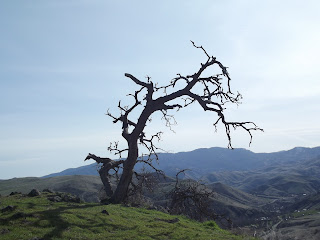 |
| Halfmoon Trestle above Highway 95 |
What on
earth is the Railroad on Stilts? This
is the nickname of the Camas Prairie Railroad, which ran through a number of
towns on the Camas Prairie of Idaho.
Although the railroad is no longer used and has fallen into disrepair –
in fact, the tracks have been pulled up in several stretches – it is still very
visible throughout the Prairie.
According
to a 1938 edition of The Lewiston Morning Tribune, the railroad was
built in 1908 in order to settle an argument between the Northern Pacific
Railroad and the Union Pacific Railroad over which one should control the Camas
Prairie. The first train ran on
December 7, 1938.
The
railroad was a major source of transportation in the area for both passengers
and goods. However, by the early
2000’s, the railroad was largely abandoned, and several sections of tracks were
pulled up, as American-Rails.com reports.
 |
| One of several tunnels along the railroad |
Even so,
many of the tracks remain, as do the several tunnels that the trains would pass
through as they made their way from Grangeville to Lewiston or back again. Most of these tunnels are short, but there
is one that makes a full ninety-degree turn and is pitch-black in the middle.
This one is located right above Highway 95 in the canyon between Winchester and
Culdesac.
 |
| The steel viaduct in Lawyer's Canyon |
The most
impressive part of this railroad, though, is what earned it the nickname of the
Railroad on Stilts: its trestles. As
the railroad wends its way through canyons and the relatively flat portions of
the Camas Prairie, it crosses numerous wooden trestles. There is even a steel viaduct in Lawyer’s Canyon that is 1520 feet long and 280 feet high at its
highest point.
The
railroad is a great place to visit. It runs through Grangeville, Cottonwood,
Ferdinand, Craigmont, Reubens, and Lapwai, connecting to Lewiston. You can easily see trestles from several of
these towns, especially Cottonwood, which has a large trestle within city
limits. There are also many trestles
visible from Highway 95 between Winchester and Culdesac.
If you’re
up for an adventure, you can see even more of them hiking. I should give you a word of caution,
though. Hiking always involves some
risks, and there are even more on railroad tracks.
The tracks
themselves are unevenly spaced and can be difficult to walk on. If you cross any trestles, be extra careful
because it’s a long drop from the top of them.
Tunnels can be dark and have falling rocks. Finally, you definitely want to check to make sure you’re not
going on private property. If you are,
you must get permission from the owner.


